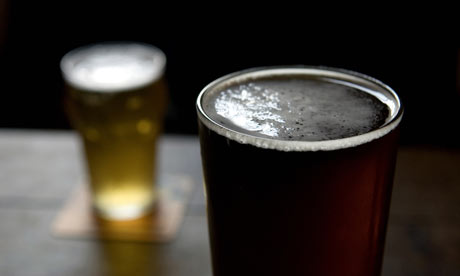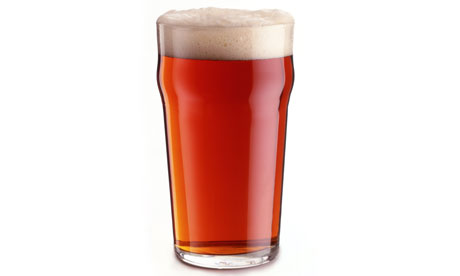I brewed an Ordinary Bitter from Brewing Classic Styles, page 117. Recipe was:
11 Gallon Batch:
Brewed on 6/15/15
Yeast starter was done ahead of time and starter size was appropriate for the batch.
Mash was 90 minutes at 152 degrees. I use a recirculating BIAB setup (hence the rice hulls). Boil was 90 minutes. Cooled rapidly with a CFC. Recirculated until down to 100 (about ten minutes), then ran through the CFC and splashed into the fermentor at 65 degrees. Wort tasted good at the end of brewing.
Starting Gravity was 1.040.
Fermentation temp was 65 degrees, measured via a thermowell in the fermentation bucket, done in a fermentation chamber controlled by a BrewPi. (I set the mode to 'Beer Constant' and the temp to 65 degrees.)
Got busy in school, so didn't bottle until 9/3/15. Tasted very good going into the bottles. Flat, but ordinary bitters are not highly carbed.
Final Gravity was 1.010.
ABV is 3.9%
Carbed to 1.7 volumes. (BDS Recipe only calls for 1 to 1.5 volumes, but I have found I need to run just a little over on my system, hence the 1.7 volumes.)
Sat three and a half weeks in my basement at approximately 75 degrees.
Opened the first bottle on 10/1/15 and found watery beer. No bad flavors, just tasteless. A little flatter than I expected. There is a little malt flavor at the end, but not anything like there was at bottling time.
Took a couple bottles to the brew club tonight and let some more experienced brewers taste the beer. Their impressions were the same as mine. No off flavors, just watery and tasteless.
I see in my searches on the forum that some people have WLP002 go bad in the bottle. The gravity drops, the carbonation skyrockets, and off flavors develop. That is not the case here. No jump in carbonation or off flavors.
Another problem is lack of time to let the beer carb, but it has been five and a half weeks at this point.
As an added kink to the problem, a porter brewed on the same day, with the same water, fermented in the same chamber, inoculated with yeast from the same starter pack, and bottled on the same day came out fine. It tastes dark, rich, slightly roasty, smooth, and properly carbed - exactly like I would expect a porter fermented with WLP002 to taste.
Thoughts? Ideas? Does WLP002 sometimes take a long time to carb up in the bottle?
Thank You,
Cody
11 Gallon Batch:
13 lbs Marris Otter
1.1 lbs 120L
0.54 lbs Special Roast
0.45 lbs Acid Malt
1 lbs rice hulls
Reverse Osmosis Water
11 grams Gypsum
6 grams Calcium Chloride
2.3 oz EKG 60 min
0.7 oz EKG 30 min
2.0 oz EKG 1.0 min
WLP002 Yeast
1.1 lbs 120L
0.54 lbs Special Roast
0.45 lbs Acid Malt
1 lbs rice hulls
Reverse Osmosis Water
11 grams Gypsum
6 grams Calcium Chloride
2.3 oz EKG 60 min
0.7 oz EKG 30 min
2.0 oz EKG 1.0 min
WLP002 Yeast
Brewed on 6/15/15
Yeast starter was done ahead of time and starter size was appropriate for the batch.
Mash was 90 minutes at 152 degrees. I use a recirculating BIAB setup (hence the rice hulls). Boil was 90 minutes. Cooled rapidly with a CFC. Recirculated until down to 100 (about ten minutes), then ran through the CFC and splashed into the fermentor at 65 degrees. Wort tasted good at the end of brewing.
Starting Gravity was 1.040.
Fermentation temp was 65 degrees, measured via a thermowell in the fermentation bucket, done in a fermentation chamber controlled by a BrewPi. (I set the mode to 'Beer Constant' and the temp to 65 degrees.)
Got busy in school, so didn't bottle until 9/3/15. Tasted very good going into the bottles. Flat, but ordinary bitters are not highly carbed.
Final Gravity was 1.010.
ABV is 3.9%
Carbed to 1.7 volumes. (BDS Recipe only calls for 1 to 1.5 volumes, but I have found I need to run just a little over on my system, hence the 1.7 volumes.)
Sat three and a half weeks in my basement at approximately 75 degrees.
Opened the first bottle on 10/1/15 and found watery beer. No bad flavors, just tasteless. A little flatter than I expected. There is a little malt flavor at the end, but not anything like there was at bottling time.
Took a couple bottles to the brew club tonight and let some more experienced brewers taste the beer. Their impressions were the same as mine. No off flavors, just watery and tasteless.
I see in my searches on the forum that some people have WLP002 go bad in the bottle. The gravity drops, the carbonation skyrockets, and off flavors develop. That is not the case here. No jump in carbonation or off flavors.
Another problem is lack of time to let the beer carb, but it has been five and a half weeks at this point.
As an added kink to the problem, a porter brewed on the same day, with the same water, fermented in the same chamber, inoculated with yeast from the same starter pack, and bottled on the same day came out fine. It tastes dark, rich, slightly roasty, smooth, and properly carbed - exactly like I would expect a porter fermented with WLP002 to taste.
Thoughts? Ideas? Does WLP002 sometimes take a long time to carb up in the bottle?
Thank You,
Cody





